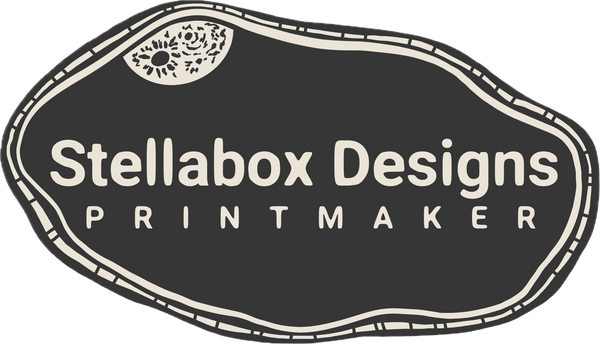
A guide to the different types of lino block
Share
There are four main types of lino block that I use to create lino print and stamps.
You can join my Patreon for more guides like this relating to linocut printmaking (I also have free posts on there, too) - here is the link to find out more.
Traditional grey hessian-backed lino blocks
My most used type of lino block, a very traditional material used by a lot of linocut printmakers. It can be difficult to see where you've carved so you'll often see printmakers staining the block surface with India ink or watered down acrylics.
Pros:
- Very widely available
- Can be bought in very large sheets and rolls
- Lovely linseed oil smell
- Shavings flake away when you carve them
- Relatively inexpensive to buy, especially when bought in bulk
- Great for fine details if your tools are kept honed
Cons:
- Best used when fresh - ideally within a year of purchase (the material can get dry and crumbly if kept for a long time so it becomes brittle and difficult to carve into)
- Can be difficult to cut down to size as the backing material is strong (there are ways around this though)
See below for grey hessian-backed lino examples...

Speedy Carve lino blocks (by Speedball)
Although not a very traditional 'lino' block, I do use this type of block in printmaking a fair bit. I began using it when I used to make logo stamps for small businesses as it lends itself well to stamping.
Pros:
- Excellent for stamping and smaller linocuts
- Presses really well into handmade paper as it's not a super rigid block surface
- Very easy to carve, great if you struggle with pain in your wrists
- Blocks can be easily cut with scissors
- Easy to clean and works well with both lino ink and oil based ink pads
- Lasts a long time without the block quality being affected
Cons:
- Expensive to buy, even in small amounts. I believe it's an import from the US, hence it's price - but it's worth it in my opinion
- It's quite unforgiving so I wouldn't recommend it if you're new to linocut as even the slightest mark or slip will show up
- Less widely available than traditional lino - I have to buy mine online
See examples of how I've used Speedball's Speedy Carve lino below...


Japanese vinyl blocks
My second favourite type of lino block to carve into. It is green on one side and blue on the other (there is not difference between the sides but I personally sketch my design onto the green side so that I can see my pencil/pen lines more easily).
Pros:
- Holds fine lines brilliantly - I can hash away at this block and it doesn't crumble
- When you carve into it, a black layer is revealed underneath, making it super easy to see where you have carved
- Relatively inexpensive to buy
- Can be bought in large sheets and cut down to size
- I find this material holds ink really well - it sits on the surface and can produce a really clean print with ease
- Lasts a long time without the block quality being affected
Cons:
- Physically, it is the granite of the lino block world - very tough to carve into (I use a thimble to save the pads of my fingers)
- Less widely available than traditional or soft cut lino so if you don't have access to the internet, it might be quite hard to source locally
See examples of how I've used Japanese vinyl below...


Softcut lino blocks (by Essdee)
I don't actually use this type of lino block for my own printmaking but I do teach beginner workshops with it.
Pros:
- Easy to carve - good for beginners
- Pencil and pen marks can be easily seen due to the creamy colour
- Holds fine lines well without crumbling or flaking
- Lasts a long time without the block quality being affected
Cons:
- I find it frustrating personally that the lino shaving doesn't automatically just flake off - if you don't get the angle of the cut right, you have to 'pick' the bit off
- Can be hard to see where you have carved as the under layer is the same colour
I hope this guide has been useful. Join my Patreon for more guides like this relating to linocut printmaking (I also have free posts on there, too) - here is the link to find out more.

